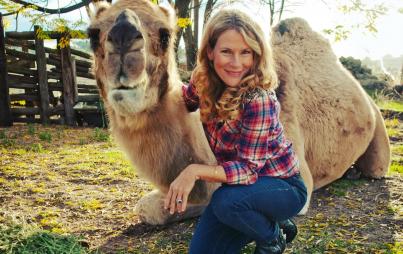
Voices from on and off the field sound off on sexism and gender inequality in sports. You can read other articles in the series here. Have a perspective you'd like to add to the discussion? Email us at ravishly@ravishly.com.
Ruth Leitman is the director of Lipstick and Dynamite, Piss and Vinegar: The First Ladies of Wrestling.
The world of women’s wrestling operates by its own particular standards of objectification, equality, and the glass ceiling. Is a level playing field possible when women and men alike prance around a ring scantily clad, hoping to be taken seriously for their agility and strength when the focus is on a prescriptive hyper-sexualized body type?
If the heyday of women’s wrestling was the 1950s (and I do believe it was), wrestling occurred in meaningful matches: two-out-of-three falls, 20-minute time limits, submission holds, signature moves, the works. Since then, women's wrestling has followed a steady digression with momentarily lapses of decline driven by "what sells." Not surprisingly, every so often, the women's match would draw the crowd and they'd "earn" themselves a real place on "the card" (the lineup of a wrestling show), not just an interstitial commercial break from the real action.
What's most interesting is that when women wrestlers like Chyna hit the pinnacle of their career, they suddenly "retire" from the machine. A press release generated by the WWE or TNA would claim the need to spend time with family or some embellished narrative, but the truth was simple: they were skilled wrestlers, some of the best—and could steal the show in this he-man's sport.
They were strong, independent, and could not be controlled. A former WWE wrestler once confided to me with great sadness that she did not own her name or image. I’ve always been struck by this notion.
We are now witnessing a new low in "corporate" women's wrestling. In WWE, they're called Divas. In TNA, they're Knockouts. They're glorified managers of male wrestlers—buff, lingerie-wearing eye candy who defend, cheer, or distract the real wrestlers in the ring (men).
The original golden girls of wrestling in my film Lipstick & Dynamite—The Fabulous Moolah, Mae Young, Gladys Gillem—worked tirelessly to pave the way for today’s women wrestlers to actually wrestle. Do the women wrestlers of today—or rather, the corporations they work for—spit on the real bloodshed and injuries of their predecessors?
In February, we hit a critical mass toward a new paradigm shift after wrestling fans suffered through a laborious 30-man battle royale. A Twitter hashtag, #GiveDivasAChance, followed.
Today’s top wrestling women executives are Stephanie McMahon, daughter of the WWE's Vince, and TNA owner Dixie Carter. I’d love to ask them: how are you contributing to gender equality in your work? Is there no way to represent women wrestlers as athletes of consequence and power, and less an accessory in the ring? Or does it simply not sell?
That all seems to have changed since #GiveDivasAChance exploded Twitter. Suddenly men and women wanted to see what The Bella Twins, AJ Lee, and Paige are there for: to wrestle. The next day, WWE CEO Vince McMahon himself tweeted, “We're listening . . . Stay tuned”—and then scrambled. Could the Divas actually shine on the existing cards for Raw, Smackdown, and Wrestlemania?
The next day, Stephanie McMahon took to Twitter after Patricia Arquette's Oscar acceptance speech about the glass ceiling, in solidarity with the actress. This was met with the ultimate smackdown from top women wrestler AJ Lee, who called BS on the tweet.
BAM! Lee announced her retirement from the WWE less than two months later.
What drives us to watch wrestling, the world’s favorite guilty pleasure pastime sport? "Killem" Gillem said it best: “It's like the gladiators, people want to be entertained and they want to see someone get killed.” Do we have a need to see another taken down, which wrestling satiates . . . and more so with women?
For those of us who have been led into the circus tent, there’s a desire to change it. If successful, we have slayed the contemporary dragon of the ultimate objectification of women. If so, we are the champions, witnessing the strong men getting their asses kicked.
What drives us to support other women (or not) in our work? I think wrestling magnifies this transgression to our solidarity as women. Studying the world for the last 12 years, I’ve been looking for that pendulum to swing. Before they passed, Moolah, Mae, Gladys, Ida, Penny, and Ella were waiting for this as well.
The CFO of professional wrestling are the fans, and last month they told the corporation they wanted to see the women in the ring doing what they do best: wrestling.







